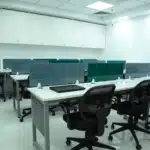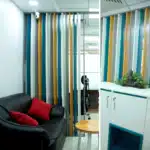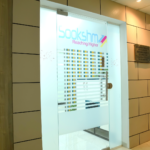Designing the Perfect “Smart Office” | Amodini interiors.
- amodini
- 0 Comments
The rise of technology has brought about a new era of office design, where smart offices are becoming more and more common. A smart office is one that utilizes technology to make work easier, faster, and more efficient. In this blog, we will discuss how to design the perfect smart office in 2023.
1. Consider your office layout
When designing a smart office, it’s important to consider the layout of your workspace. Think about the flow of traffic and how you can optimize the space for better efficiency. Consider implementing a flexible workspace with movable partitions, which can easily adapt to changing business needs and provide an open, collaborative environment.
2. Use the latest technology
The latest technology is crucial when designing a smart office. Use devices like smart assistants, wireless charging, and automated lighting and temperature control to streamline your workflow and optimize energy consumption. The Internet of Things (IoT) can be used to connect all of your devices, allowing them to work together seamlessly.
3. Invest in high-quality hardware and software
The hardware and software you choose for your smart office are critical to its success. Invest in high-quality equipment, such as laptops and printers, and software that can help you automate and optimize your workflows. Look for solutions that integrate with other technologies and offer cloud-based storage and collaboration.
4. Use biometric security
Biometric security is a key feature of a smart office. Consider using fingerprint or facial recognition systems for access control and to ensure that only authorized personnel can access sensitive information.
5. Implement a centralized control system
A centralized control system is essential for managing all of the devices and systems in your smart office. This allows you to monitor and control everything from a single dashboard, making it easy to make adjustments and keep your office running smoothly.
6. Incorporate natural elements
While technology is critical for creating a smart office, it’s also essential to incorporate natural elements such as plants, natural lighting, and ergonomic furniture. These elements can help to create a calming environment and improve productivity.
7. Create a collaborative workspace
A collaborative workspace is essential for a smart office. Consider implementing collaborative tools such as video conferencing and team collaboration platforms that allow employees to work together seamlessly, no matter where they are located.
Designing a smart office is essential to optimize your workspace and streamline your workflows. Consider your office layout, invest in the latest technology, use high-quality hardware and software, incorporate natural elements, and create a collaborative workspace.
By implementing these strategies, you can create an office that is efficient, productive, and easy to use. Remember that a smart office is not just about technology, but about creating an environment that promotes collaboration, creativity, and innovation.





















